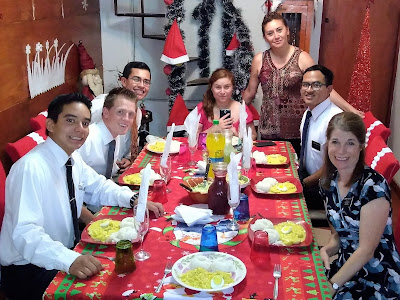variety and excellent prices of fruits and vegetables available at local ferias (outdoor produce markets) and we shop there at least once a week, often twice. All the Chileans use small carts to carry their purchases in. After a few times struggling with our backpacks we smartened up and got our own matching polka-dot feria carts!
The produce is great but the experience adds so much more. Vendors line the street on both sides. Some haphazardly pile their produce for display. Others carefully and artfully stack and arrange them. Some quietly tend their stands and serve their customers. Others holler incessantly their advertisements and inducements. There's never a lack of dogs. Unfortunately, they feel the need to mark their territory, sometimes on stacks of produce to be sold. Always wash your purchases carefully! If you get to the feria at 10:30am there's a crush of people and it takes forever to work your way through the crowd. At 9:00am there are fewer customers to compete with but many vendors are still setting up. Price signs are frequently not yet posted so you have to ask. Most vendors are honest. Some not so much. You can almost see the thoughts racing through their minds and the resulting hesitation, something like: aha - rich gringo!, my advantage, how much can I reasonably raise the price, mental addition, resulting final inflated price. And then they answer. This week I went to purchase cherry tomatoes that were posted last week at 1000 pesos a kilo. He quoted me 1500 this time. He didn't make the sale. After such experiences, shopping at supermarkets seems so stale now!
We have found that Chilean food tends to be more bland than we're used to. Not that it doesn't
taste good. There are just fewer sharper and contrasting flavors, fewer seasonings. One thing is for sure. The Chilean tongue generally can't handle hot and spicy. And this observation comes from two people who consider themselves weak in that category. Case in point. At a ward cookout we were given a longaniza (sausage) in a bun. A sister mixed some merkén (a smoked hot red pepper powder which originated here with the Chilean indigenous people) into mayonnaise for a condiment. Teresa enjoyed the small sample she tried and proceeded to slather a thick layer over the length of the longaniza, to the warnings and protests of everyone there. They claimed it would be too spicy hot. Undaunted she enjoyed bite after bite to the surprise of everyone. I found the merkén to be spicy but not overbearing, adding a nice little kick. We don't have a picture of Teresa's great feat but we do have one of Obispo Miranda manning the cooker. Note the longaniza next to the pork.
Elder Rodriguez hails from Asuncion, Paraguay where our daughter Jessica served her mission
(but they never met). Turns out he was a chef back home too, loves to cook, and asked if he could prepare Christmas dinner for us. Of course! He wanted to make one of his favorite dishes called Milanesa, which by its very name suggests it originated in Milan, Italy. It's a type of fried breaded chicken that tastes wonderful. We picked up the ingredients and he took it from there, commandeering the kitchen as Teresa observed and learned (she wants to bring the best recipes back home with us). He even donned Teresa's apron - pretty cute! Teresa rounded out the meal with mashed potatoes, asparagus, carrots, and rolls.
That day we had over for dinner Elders Rodriguez and Vera and the other companionship living in their apartment, Elders Fowles and Anderson, as well as the Hendricks, the senior couple working in the mission office. Sister Hendricks brought a delicious chocolate cake which we have enjoyed again since and hope to enjoy many more times yet.
We met a very vivacious sister, Hermana Pilar, who loves to feed the missionaries. We were
 |
| Hna Pilar is standing and Elder Calixto is between her and Teresa. |
great cook I prefer her food to nearly every restaurant we've been to anyway (and I'm such a good sous-chef she gets lots of help in the kitchen!).
Anyway, we spent one P-day climbing around Cerro Santa Lucía in downtown Santiago, a hill with historical significance and a nice view of the city. Afterwards we stopped at a street side restaurant for a bite. The waitress was very helpful and sweet and when we struggled to understand what a specific menu item was she summoned her English-speaking boyfriend/co-owner/cook to help us out. We had a delightful meal on that sidewalk chatting with the waitress and her boyfriend, watching busy people walk by, taking in the sites and sounds and everything Chilean. It's true, the food turned out to be bland as expected. But the people, the people are warm and sweet and welcoming. We love them and we're so happy to be here with them.
I hope you enjoyed our little culinary tour. It's probably a bit premature since there is so much more we haven't experienced yet, from the varieties and delicacies to be found in the multitude of local restaurants and cafes to the simple aromas, textures, sights and sounds familiar in the kitchens of common Chilean families. I love this part of being a missionary too. Heavenly Father has created a world of such variety and diversity. We just need to jump in and enjoy - more adventures await!





